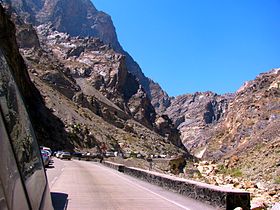Grand Trunk Road

The Grand Trunk Road (short GT Road or GTR ) is the English name of a long-distance trade route in South Asia . With an age of at least 2500 years it is one of the oldest and most important transport links in Asia. The approximately 2500 km long road follows much of the north Indian Ganges plain and has been a traffic route between today's states of Pakistan , India and Bangladesh for centuries . The part of the name trunk (" trunk ") stems from its slightly curved and upward course from east to west.
course
In India, the starting and ending points of the Grand Trunk Road are Chaiber Pass in the west and Kolkata in the east. It runs through the cities of Amritsar , Ambala , Delhi , Agra , Kanpur , Prayagraj , Varanasi and Kolkata. The western part between Delhi and Wagah runs today under the designation National Highway 1 (NH-1) ; the eastern part between Kolkata and Delhi is called National Highway 2 (NH-2) .
In Pakistan, the road leads from Peshawar via Rawalpindi and Lahore to the Indian-Pakistani border crossing at Wagah . In Bangladesh it runs through Chittagong and ends in Sonargaon in the Narayanganj district . The Afghan part between Jalalabad and Kabul does not belong to the GTR in the narrower sense , but it is often included.
history
Already at the time of the ancient Maurya Empire , part of the as yet unpaved road was used by the Bactrian Greeks , among others . In the 16th century, the road was expanded by Sultan Sher Shah Suri to create a connection between Agra , his residence city, and Sasaram , his hometown. It was called Sarak-i-Azam ("Royal Road") and formed the basis of today's Grand Trunk Road . In the course of time the road gained great importance as a supraregional trade route. After its completion, the street was lined with numerous mile towers ( Kos-Minars ), caravanserais and draw wells ; in addition, trees were planted along the road to provide shade. From then on, it also served to improve the transport infrastructure and relocate military units. Only a few years later, the road was extended west to Multan and east to Sonargaon in Bengal (now Bangladesh). After the death of Sher Shah in 1545, the road was extended to the west, over the Chaiber Pass in the Hindu Kush to Kabul in what is now Afghanistan .
Under British rule - then renamed Long Walk - the road was expanded again, then to Kolkata and Peshawar .
During the partition of India and Pakistan at the end of colonial rule in 1947, the Grand Trunk Road was the scene of the worst refugee fatalities in modern history , when the Hindus fled from the newly formed Pakistan to what is now India and many Muslims in the opposite direction.
Attractions
Several places along the GTR are among the UNESCO - World Heritage Sites : Taxila , Lahore , Delhi , Agra , Varanasi , Bodhgaya , Bagerhat . But other places like Mathura , Prayagraj or Kolkata are of great historical and cultural significance.
Others
Rudyard Kipling's novel Kim is set largely on and along Grand Trunk Road .
literature
- Tim Smith: Grand Trunk Road. From Delhi to the Khyber Pass. Dewi Lewis Publ., Manchester 2011, ISBN 978-1904587996
- Abdul Khair Muhammad Farooque: Roads and Communications in Mughal India. Idarah-i-Adabiyat, Delhi 1977
- Anthony Weller: Days and Nights on the Grand Trunk Road: Calcutta to Khyber. Da Capo Press, Boston / Mass. 1998, ISBN 978-1569246702
Web links
- Grand Trunk Road Article (Lonely Planet)
- Grand Trunk Road - Photo + Quick Info (Archnet, English)

